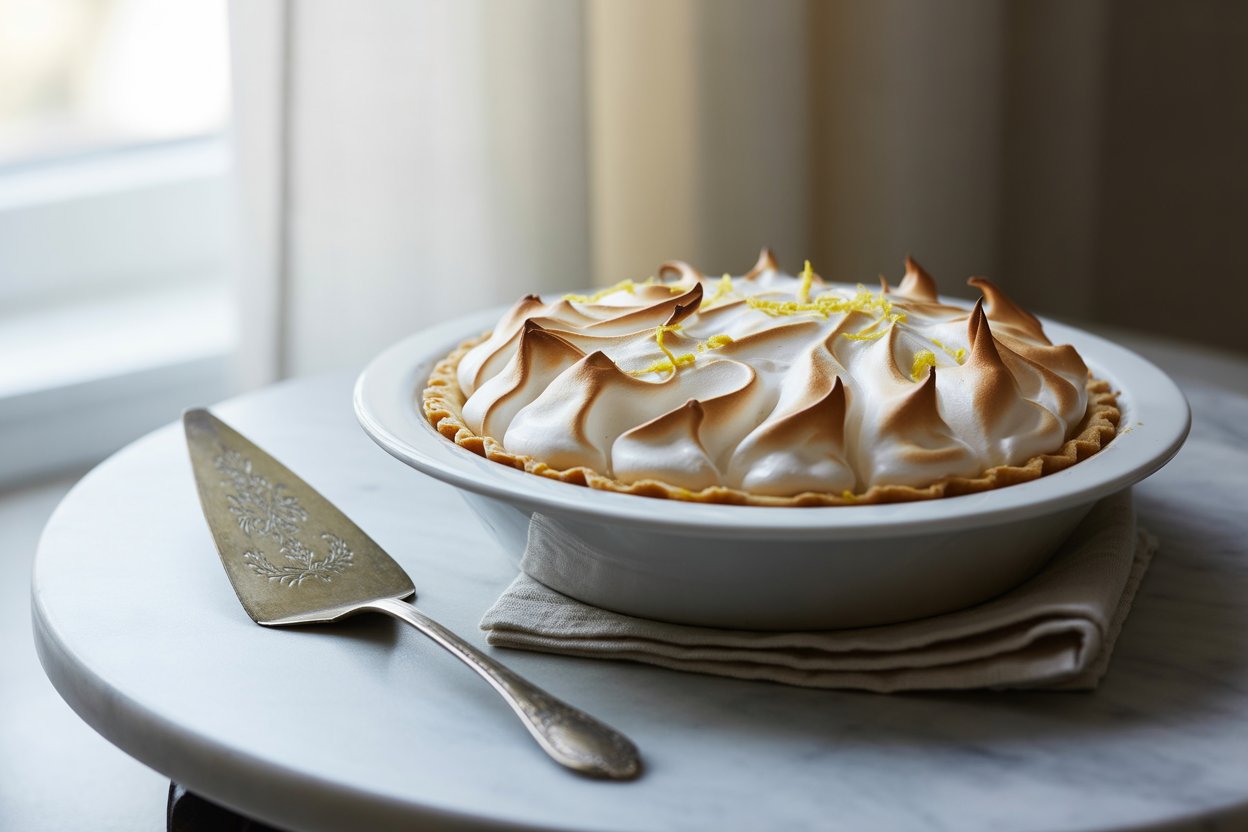This pie hits the brief: crisp pastry, glossy meringue, and a lemon filling that actually tastes like lemons. The workflow is simple and reliable. You’ll prep the custard, temper the yolks, finish with butter and citrus, then cap it with a stable meringue. The output is a bakery-level slice that satisfies key KPIs: clean cuts, no weeping, and real flavor. Let’s execute.
What You’ll Need
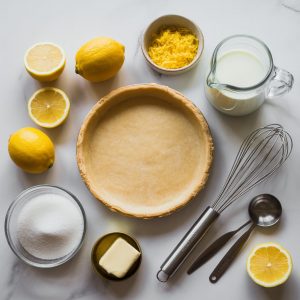
Ingredients
- Sugar: 1 7/8 cups total
- Use 1 1/2 cups for the filling
- Reserve 1/4 cup + 2 tablespoons for the meringue
- Cornstarch: 1/3 cup
- Salt: 1/4 teaspoon
- Milk: 2 cups
- Eggs: 3 large, separated, plus 1 extra egg white
- Lemon rind: 1 1/2 teaspoons, finely grated
- Fresh lemon juice: 1/2 cup
- Butter: 2 tablespoons
- Baked 9-inch pastry shell
- Cream of tartar: 1/2 teaspoon
Equipment
Heavy saucepan, balloon whisk, stand or hand mixer, rubber spatula, microplane, 9-inch pie shell, measuring cups and spoons, oven set to 350°F / 175°C.
Step 1: Build the Lemon Custard Base
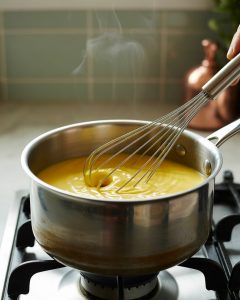
Combine 1 1/2 cups sugar, 1/3 cup cornstarch, and 1/4 teaspoon salt in a heavy saucepan. Whisk to remove any dry pockets. Gradually stream in 2 cups milk, whisking until smooth. Place over medium heat. Cook and stir constantly until thick and bubbling. Let it gently boil for 1 minute, still stirring. This activates the cornstarch and sets your texture baseline. Remove from the heat.
Step 2: Temper the Egg Yolks
Place the 3 egg yolks in a mixing bowl. Beat at high speed until thick and lemon-colored. This step adds structure and a fine texture. Slowly whisk about one quarter of the hot milk mixture into the yolks. Keep the mixer moving to avoid scrambling. Return the tempered yolk mixture to the saucepan with the remaining custard. Put the pan back over medium heat. Cook 2 to 3 minutes, stirring constantly, until silky and just bubbling. Remove from the heat.
Step 3: Finish With Lemon and Butter
Stir in 1 1/2 teaspoons grated lemon rind, 1/2 cup fresh lemon juice, and 2 tablespoons butter. Mix until the butter melts and the custard looks glossy. Taste for balance. It should read bright, not harsh. Pour the hot filling into the baked 9-inch pastry shell. Smooth the surface. Keep it hot for the next step. Hot filling helps the meringue anchor and reduces weeping.
Step 4: Whip a Stable, Glossy Meringue
Add 4 egg whites (the 3 from separating plus 1 extra white) and 1/2 teaspoon cream of tartar to a clean, grease-free bowl. Beat on high speed until foamy. With the mixer running, add the remaining sugar (1/4 cup + 2 tablespoons) 1 tablespoon at a time. Beat to stiff peaks. The meringue should look thick, shiny, and hold its shape. If it looks grainy, you added sugar too fast. If it slumps, keep beating.
Step 5: Cap the Pie and Seal the Edge
Spread the meringue over the hot filling right away. Start with a thin layer to erase any gaps. Then mound the rest and create swirls. Seal the meringue to the crust all around. That seal is non-negotiable. It prevents shrinkage and locks in steam where it belongs.
Step 6: Bake to Color and Set
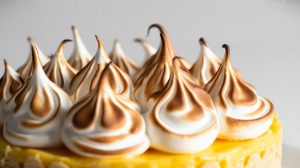
Bake at 350°F / 175°C for 12 to 15 minutes, until the peaks turn golden brown. You want color on the ridges and a set, marshmallow-soft interior. Pull the pie when it looks glossy and bronzed, not dry.
Step 7: Cool for Clean Slices
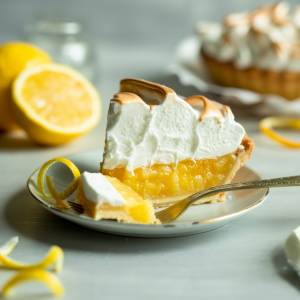
Cool the pie on a rack until it reaches room temperature. Then chill until set if you want razor-sharp slices. Use a hot, dry knife for service. Wipe the blade between cuts to protect the layers.
Why This Method Works
- Boil time locks the starch. That one-minute simmer activates the cornstarch and prevents a gummy finish.
- Tempering protects the yolks. Heat the yolks gradually and you avoid curdling while gaining body and color.
- Hot filling anchors the meringue. Spreading meringue on hot custard helps cook the underside and reduce weeping.
- Sugar-by-tablespoon builds structure. Slow sugar addition creates a fine, stable foam with tight, glossy bubbles.
- Edge seal drives success. Attaching meringue to the crust prevents shrinkage and cracking during bake.
Pro Tips for Peak Performance
- Use fresh lemons. Bottled juice lacks the aromatic oils you get from fresh rind and juice.
- Keep tools spotless. Any fat on the bowl or whisk weakens the meringue matrix.
- Mind the heat. Medium heat gives you control. High heat risks scorching and lumps.
- Don’t overbake. A dry, crumbly meringue weeps later. Bake to color, not to crunch.
- Plan your timeline. Meringue likes hot filling. Have the whites ready to whip as the custard finishes.
Troubleshooting Guide
- Weeping meringue: Usually from undercooking, sugar dumped too fast, or meringue spread on cool filling. Bake to color, add sugar gradually, and always spread on hot filling.
- Beading (syrupy droplets on top): Often from overbaking. Pull it when peaks are golden, not dark brown.
- Soupy filling: Cornstarch under-activated or not boiled long enough. Next time, keep the 1-minute simmer and the extra 2 to 3 minutes after tempering.
- Shrunken meringue cap: Edge wasn’t sealed to the crust. Press meringue firmly to the pastry all around.
- Grainy meringue: Sugar added too quickly or whites overbeaten before sugar. Add sugar slowly from the foamy stage.
Serving and Storage
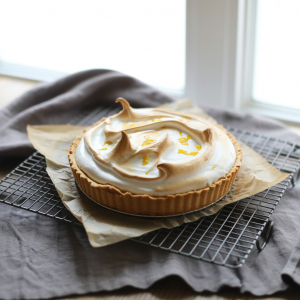
Serve at cool room temperature for the best texture. The citrus lands brighter and the meringue stays plush. Store leftovers in the refrigerator, uncovered for the first hour, then lightly tent with parchment. Avoid plastic wrap touching the meringue, which causes sticking and smearing. Consume within 24 to 36 hours for peak quality.
Make-Ahead and Workflow Planning
- Crust: Blind-bake and cool the pastry shell earlier in the day, or the night before.
- Lemons: Zest first, then juice. Measure both before you start the custard.
- Mixer readiness: Clean and dry the whisk and bowl so you can whip the whites on cue.
- Service window: Bake the meringue within an hour of finishing the filling. Cool, then hold chilled until serving.
Ingredient Recap (for Quick QA)
- Sugar: 1 7/8 cups total (1 1/2 cups filling; 1/4 cup + 2 tbsp meringue)
- Cornstarch: 1/3 cup
- Salt: 1/4 tsp
- Milk: 2 cups
- Eggs: 3 yolks for filling; 4 whites for meringue
- Lemon rind: 1 1/2 tsp
- Lemon juice: 1/2 cup
- Butter: 2 tbsp
- Baked pastry shell: 9 inches
- Cream of tartar: 1/2 tsp
- Oven: 350°F / 175°C, 12–15 minutes for the meringue
Final Notes for a High-Confidence Deliverable
Respect the boil, seal the edge, and bake to light gold. Those three checkpoints drive consistent outcomes and protect quality at scale. When executed as written, this pie delivers a crisp crust, a smooth lemon layer, and a meringue that stands tall without weeping. Consider the project closed, with stakeholders fully satisfied at first bite.

